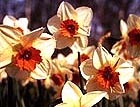Garden history: gardens on film
Tim Richardson says the history of gardens on film through the years is a rich seam to be mined, from public information films to Hollywood blockbusters


The ‘makeover’ culture of the late 1990s encouraged the view that gardening be considered as an outdoor version of DIY a grim conclusion, but possibly an improvement on the prevailing popular attitude, that gardening should be reserved exclusively for retirement. But that is not, and has never been, the whole story: the past few years have seen a surge of interest in the idea that gardens might be understood in the wider context of the Arts and Sciences. After all, why should gardeners who tend to be intelligent, curious and, by definition, energetic people leave their brains behind when they go outside to ‘become’ gardeners? For most, gardening isn’t just a matter of how to grow potatoes or dahlias, but a precious interaction with Nature, a means of creative expression, a communal effort, a never-ending technical experiment and, above all, a deeply pleasurable and satisfying activity.
A few years ago, fellow garden writer Noel Kingsbury and I decided to try to stimulate this burgeoning interest in deeper thinking about gardens by means of a volume entitled Vista: The Culture and Politics of Gardens. Its 17 essays are on topics such as gardens and philosophy, the history of women and gardens, and the meanings of ‘nature’ in a garden context.
On the heels of a successful initial Vista event at the Hay Festival in 2007, this little venture has spawned two seasons of monthly guest evenings at the revamped Garden Museum in Lambeth (formerly the Museum of Garden History, www.gardenmuseum.org.uk). These events tend to involve the intense cross-examination of willing victims drawn from the ranks of garden designers, artists, critics and scholars (most recently, Penelope Hobhouse).
Meanwhile, the museum, formerly a rather moribund collection of garden tools, has itself become a focus for intelligent thinking about gardens under its dynamic new director, and the museum’s inaugural exhibition, on Beth Chatto, manages to be both serious and charming. A recent Vista evening hosted by the museum was devoted to the subject of gardens and film, with Peter Todd of the British Film Institute (BFI) introducing four shorts that will be shown (with others) at the BFI in April, as part of a special season.
First up was a 1941 public-information film called How to Dig, which was surprisingly meditative, in that its entire 14 minutes consisted of a flat-cap-wearing gardener, drooping roll-up cigarette attached to his lower lip, demonstrating various methods of double digging. At one point, a young woman in a fetching beret-and-trench-coat combination appeared solely, it transpired, in order to show us how not to do it. As she waggled her spade about, the voiceover exclaimed incredulously: ‘She’s holding it like a spoon!’ When she got it right, the voice intoned: ‘That’s more like it!’
The evening made me reflect on the different ways gardens and film interact. There are public-information films, such as How to Dig; ‘scientific’ films, such as Microcosmos; or children’s films, including A Bug’s Life, which present the garden as a world in miniature. In Hollywood, gardens are often used to bolster the well-worn notion of ‘the American dream compromised’, with the archetypal suburban American lawn and white picket fence caricatured, as in David Lynch’s Blue Velvet, or else ripped up and desecrated by ghosts or zombies in horror flicks such as the ‘Amityville Horror’ series.
In the British tradition, gardens tend to be associated with a timeless, often quasi-supernatural milieu I’m thinking of The Draughtsman’s Contract (shot in the grounds of Groombridge Place, Kent), the climactic scene of Four Weddings and a Funeral (set in a private London square during a rainstorm), or the time-lapse magic of the 1993 film of The Secret Garden. Just occasionally, however, the garden itself is the theme, rather than the setting. Derek Jarman’s The Garden, shot in and around his own garden on the shingle beach at Dungeness, Kent, is probably the best example of this from recent decades, although, like all of his films, it’s something of an acquired taste. Despite these evident synergies, nothing substantial has been published on the subject of gardens and film. It appears that gardens are a rich cultural seam just waiting to be mined.
Sign up for the Country Life Newsletter
Exquisite houses, the beauty of Nature, and how to get the most from your life, straight to your inbox.
Country Life is unlike any other magazine: the only glossy weekly on the newsstand and the only magazine that has been guest-edited by HRH The King not once, but twice. It is a celebration of modern rural life and all its diverse joys and pleasures — that was first published in Queen Victoria's Diamond Jubilee year. Our eclectic mixture of witty and informative content — from the most up-to-date property news and commentary and a coveted glimpse inside some of the UK's best houses and gardens, to gardening, the arts and interior design, written by experts in their field — still cannot be found in print or online, anywhere else.
-
 About time: The fastest and slowest moving housing markets revealed
About time: The fastest and slowest moving housing markets revealedNew research by Zoopla has shown where it's easy to sell and where it will take quite a while to find a buyer.
By Annabel Dixon
-
 Betty is the first dog to scale all of Scotland’s hundreds of mountains and hills
Betty is the first dog to scale all of Scotland’s hundreds of mountains and hillsFewer than 100 people have ever completed Betty's ‘full house’ of Scottish summits — and she was fuelled by more than 800 hard boiled eggs.
By Annunciata Elwes